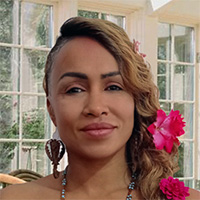July 2025 Tarot Overview: Analysis of the Nine of Cups
 As July unfolds, the invigorating essence of the Nine of Cups appears, heralding a month brimming with potential and personal development. Known as the “wish card,” this tarot symbol foretells a time of accomplishment, gratitude, and emotional tranquility. It inspires us to take pleasure in the joy of our successes this month and to reflect on our journey so far.
As July unfolds, the invigorating essence of the Nine of Cups appears, heralding a month brimming with potential and personal development. Known as the “wish card,” this tarot symbol foretells a time of accomplishment, gratitude, and emotional tranquility. It inspires us to take pleasure in the joy of our successes this month and to reflect on our journey so far.
The Nine of Cups embodies not just outward achievement, but also the significant realization that true contentment is sourced from within ourselves. It motivates us to root ourselves in self-acceptance and inner joy, allowing that inner peace to shine through every facet of our existence.
This July, let’s make it a month for reveling in life’s delights and embracing various forms of emotional richness. From fostering connections to personal victories and peaceful moments, let’s strive to make this July an unforgettable one!
This card holds tremendous significance, and it’s remarkable to observe its influence on individuals. It doesn’t shout for attention; instead, it exists in the assurance that everything is as it ought to be. As you navigate through this month, contemplate what it truly feels like to be “fulfilled.” It’s not merely about possessions, but involves spiritual, emotional, and energetic aspects as well! Which aspirations have been realized, and which new dreams are beginning to emerge?
The Nine of Cups is emblematic of fresh starts and new arrivals. It often signifies an exhilarating pause between different life stages, calling for celebration and reflection. It invites us to express gratitude for what we have and who we are evolving into. Whether you’re relishing long-deserved rewards or learning to cherish everyday moments, July is the perfect opportunity to trust your inner wisdom and savor the richness of now.
The Nine of Cups is also known as the wish card, indicating that your desires or ideal dreams are set to manifest. The Nine of Cups is typically linked with profound happiness and satisfaction ~ Tina Gong
<pThe Nine of Cups is usually depicted with a joyful figure on a bench, arms crossed and smiling broadly. Behind this figure, nine gleaming cups are artistically arrayed on a curved stand, visually representing emotional bounty, fulfillment, and realized dreams. The figure’s stance radiates pride and confidence while also conveying a tranquil serenity. The cups stand for emotional wealth; each one symbolizes a fulfilled wish or source of joy.
The card’s modest backdrop serves as a beautiful reminder that genuine happiness is often found within, nestled in life’s simple pleasures. The curved table behind the seated figure can be interpreted as a protective embrace of the treasures we hold dear. The warm, inviting colors enhance the ambiance of comfort and satisfaction.
Overall, the Nine of Cups shines brightly this month, encouraging us that while pursuing our dreams is important, it’s equally vital to celebrate and relish the beautiful milestones we have already reached. It prompts us to take a moment to recognize our achievements, to delight in the joy of a life well-lived, if only momentarily.
This card can serve as a reminder to fully appreciate the abundant pleasures in your life. Even seemingly simple things, like a comforting bowl of cereal and a sturdy roof over your head, can feel like the ultimate luxuries if you have the right mindset. Embracing gratitude is essential ~ Carrie Mallon
Here are the key focus areas for this month:
Health & Well-Being
Emotional balance plays a crucial role in your overall wellness this month. The Nine of Cups suggests that our bodies thrive when we experience emotional fulfillment. Expect to feel more vibrant, relaxed, and attuned to your physical needs. Now is an excellent time to indulge in simple joys that uplift you, such as nourishing meals, time spent in nature, meaningful rest, and activities that inspire you. However, this card also signals the potential for overindulgence, so be cautious not to excess in food, drink, or screen time. Finding balance is essential. Consider integrating small wellness practices that bring joy and relaxation. Hydration, sufficient sleep, fresh air, and mindful movement will help maintain your energy.
Money & Finances
From a financial perspective, July brings a sense of stability and possible rewards. The Nine of Cups is often linked with abundance and ease, hinting at a possible financial breakthrough or increased confidence in your current situation. This month favors wise expenses, generous giving, and enjoying the fruits of your labor without guilt. If you have been striving toward a financial goal, you may see tangible progress now. Nonetheless, the card gently reminds you that money is merely a tool and should not define your self-worth. Use this opportunity to evaluate your financial priorities and share your prosperity in alignment with your values. Gratitude and generosity can amplify your wealth.
Career and Business
Career prospects thrive in this supportive energy. You may feel a sense of achievement, especially if you’ve committed yourself to a long-term endeavor or have recently reached a goal. This month could bring recognition, rewards, and promotions. Now is the ideal moment to celebrate your professional journey while preparing for your next chapter. Confidence is your secret asset right now. The Nine of Cups reassures you that you possess the necessary skills, insight, and resilience to flourish. If you’re contemplating a career shift or new opportunity, approach it with optimistic assurance. Networking and collaboration are also encouraged—your energy is attractive, and others will be drawn to your self-assured charm.
Love & Relationships
In terms of love, the Nine of Cups exudes warmth and emotional fulfillment. Whether in romantic or platonic relationships, expect to experience appreciation and harmony. If you are in a relationship, look forward to deeper intimacy and shared joy. Gratitude is your love language this month; small gestures of kindness and genuine recognition will strengthen your bonds. For those who are single, the card communicates a message of alignment. It encourages you to prioritize your happiness, as radiating it will naturally draw like-minded connections into your life. Rather than pursuing love, allow it to find you through your own inner fulfillment.
Personal Growth
July is a month marked by spiritual and emotional reflection, as well as joyful self-awareness. The Nine of Cups asks: What truly brings you fulfillment? Now is the perfect moment to explore your innermost wishes, beyond those dictated by society. Self-love, gratitude, and intentionally celebrating your growth are central themes. Journaling, meditation, or merely pausing to appreciate the now can offer valuable insights. If you’ve sought happiness through external validation, this month serves as a gentle nudge that your joy resides deep within you. Embrace authenticity, nourish your spirit, and trust that your path is unfolding at just the right moment.
July 2025 is a time for emotional abundance, meaningful achievements, and soulful celebration. With the Nine of Cups guiding you, embrace the joy of the present moment, honor your accomplishments, and deepen your connection to what genuinely fulfills you. Trust your inner wisdom, practice gratitude, and allow your heart to lead your next steps with clarity and confidence.
|
Zondra is a highly accomplished Intuitive and Life Coach, sharing her unique talents developed over the last 20 years. Zondra serves as the guiding hand for her clients, aiding them in selecting the optimal path for their dreams to manifest. A fifth-generation psychic, her innate gifts and inquisitive nature have led her to explore and master NLP and Mental Training, seamlessly blending coaching methods with Tarot. She has advised many on both national and international platforms and has supported organizations in Portugal, the UK, Ireland, Norway, Sweden, Denmark, Brazil, and the US. Zondra utilizes her experience to empower others in making significant and genuine changes in their lives. If you’re eager to transform your life’s trajectory swiftly, you’ve found a compassionate, open-minded practitioner, gifted in assisting you to manifest the life you aspire to live. You can connect with Zondra at PsychicAccess.com. |
The Nine of Cups is a Tarot card often linked with joy, fulfillment, and emotional contentment. In the context of a Tarot forecast for July 2025, the appearance of the Nine of Cups indicates that this month will be a period of significant happiness and satisfaction for many individuals.
When this card surfaces in a Tarot reading, it signifies that your wishes and aspirations are likely to materialize soon. This could take various forms, such as accomplishing a long-standing goal, receiving positive news, or experiencing profound inner peace and contentment. It is a period for celebrating your successes and feeling proud of your journey.
Regarding relationships, the Nine of Cups suggests that your emotional needs will be met, leading to a deep sense of connection with those around you. This might foster a period of harmony and closeness with loved ones, alongside heightened romance and passion in your personal relationships.
In the spheres of career and finances, the Nine of Cups implies that you will experience prosperity and growth in these domains. This could result in a promotion, a financial gain, or simply a heightened sense of security and stability in your financial circumstances. It’s a favorable time to concentrate on your goals and ambitions, as you are likely to witness positive outcomes from your efforts.
In summary, the Nine of Cups is a very positive card indicating a time of immense joy and fulfillment across all aspects of your life. It’s a time to engage with the things that spark joy and to recognize the blessings that fill your life. Embrace this energy and allow yourself to bask in the feelings of contentment and satisfaction that accompany it. Continue reading
















